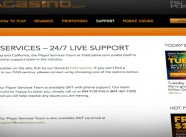Should WSOP Tournament Coverage Include a HUD?
This year PokerNews.com’s live reporting team added a new feature to their World Series of Poker Main Event coverage that caused somewhat of a stir, a HUD (Heads Up Display) showing key stats for players at the featured table.
Some players, including one of the game’s best, Chris Moorman, took exception to PokerNews tracking player stats in real time for just a single table.
Completely disagree with the decision from @pokernews to provide us with a live HUD of the WSOP Main Event. Really not fair for the players
— Chris Moorman (@Moorman1) July 14, 2014
I’m not going to rehash the fairness arguments here, since Lee Davy at CalvinAyre.com has done an excellent job of that already. But there is another aspect of this more technical and data driven coverage of tournament reporting that I do want to talk about, and that is…
What does it add to the coverage?
Not that blogging about a tournament is ever going to bring the hits, but what exactly does a HUD add to the coverage of the event?
In a response to Lee Davy, PokerNews’s Donnie Peters did make the point that the audience is more sophisticated (and this is especially true for the audience following along to live reporting) and appreciates this “extra layer” of coverage.
But here is the thing, this audience is already there and following along. It’s like adding a player’s batting splits or a pitcher’s percentage of curveballs thrown to changeups, it’s a fun little number for the die-hard fans that are tuning in, but the average fan just tunes out.
We should be trying to find ways to reach out to the audience who isn’t already following along, and in my opinion that means more videos, interviews, and key hands – less data, chip counts, and other “sophisticated” elements.
Do people suddenly head to PokerNews.com because of the HUD? No.
The people who are already following the PokerNews coverage (which is excellent by the way) might think, “oh a HUD, that’s kind of neat.”
Following up on Moorman’s concern, imagine if FOX relayed this information in-game but only for one team’s pitchers?
Furthermore, I see it as a potential turnoff for amateur players because…
It sends the wrong message
It’s not 2007 anymore, and amateur players are keenly aware of how pros are using software and player stats to gain edges. It’s not that amateur players don’t have access to these tools (they do), or that they don’t know what VPIP and PFR percentages are, the problem is they are not as adept at using this information as a pro.
Amateur players have no problem with collecting the data or understanding what it means on a general level. Where they are at an extreme disadvantage is when they try to make adjustments based on this data.
Sure they can see that one player is 3-betting far more than the norm, but what’s the correct 4-betting percentage to exploit this player? A pro would know; an amateur would not.
They can collect but they have a hard time processing.
Yet another issue I see with the use of a real-time HUD is one of perception, as…
There is a lot of camaraderie between reporters and players
Tournament reporters and the players they cover spend a lot of time together. They are around the same age, and obviously share similar interests, so it’s no surprise that they become friendly, and quite frankly it’s not a big deal.
That being said, take a look at it from an outsider’s perspective.
They see players and reporters tweeting at one another with a certain familiarity, talking about grabbing something to eat later on, and so on and so forth. Now they see these same reporters essentially compiling stats on players, which almost certainly benefits the pros they cover day-in and day-out, and in some cases are friends with.
Don’t get me wrong, I don’t think this is intentional on the part of PokerNews or anyone else, but it could lead to people drawing that conclusion.
Finally…
Live poker is not online poker
Live poker and online poker are not the same thing, they’re about as similar as Limit Five Card Draw and No Limit Holdem, and we need to stop trying to find ways to make them resemble one another.
In his response to Davy, Matthew Parvis of PokerNews.com states:
“I think it’s great to see the type of detail that can be found online used in the coverage of a live event.”
No, no, and no. You’re missing the point of live poker. The point of live poker, the reason so many players are willing to plunk down $10,000 to play in the Main Event is because it’s NOT online poker.
There is an element to live poker that adds another layer to the game.
Online poker is about making the correct mathematical decision, but in a live poker tournament where you’ve played all of five orbits at the table your reads and your ability to focus on the game and process the information you have personally seen comes into play.
You may feel the button is playing a few too many hands and not raising enough, but you don’t know he’s running 30/9 with a .8 AF over 55 hands. This is information live players are not supposed to have at their fingertips.
Adding a HUD to the coverage changes this dynamic. It lessens a player’s reliance on their reads.
Certain hands play out differently live than they would online and the reason is the incomplete information which forces players to rely on the other aspects of live poker and not simply on what the math says to do.
Final thoughts
I’m not really against the HUD per se, but I just don’t see what positives it brings that outweigh the potential negatives.
I think PokerNews would be much better served to scrap it during live play and maybe toss up the stats at the end of the day in their wrap up article.






